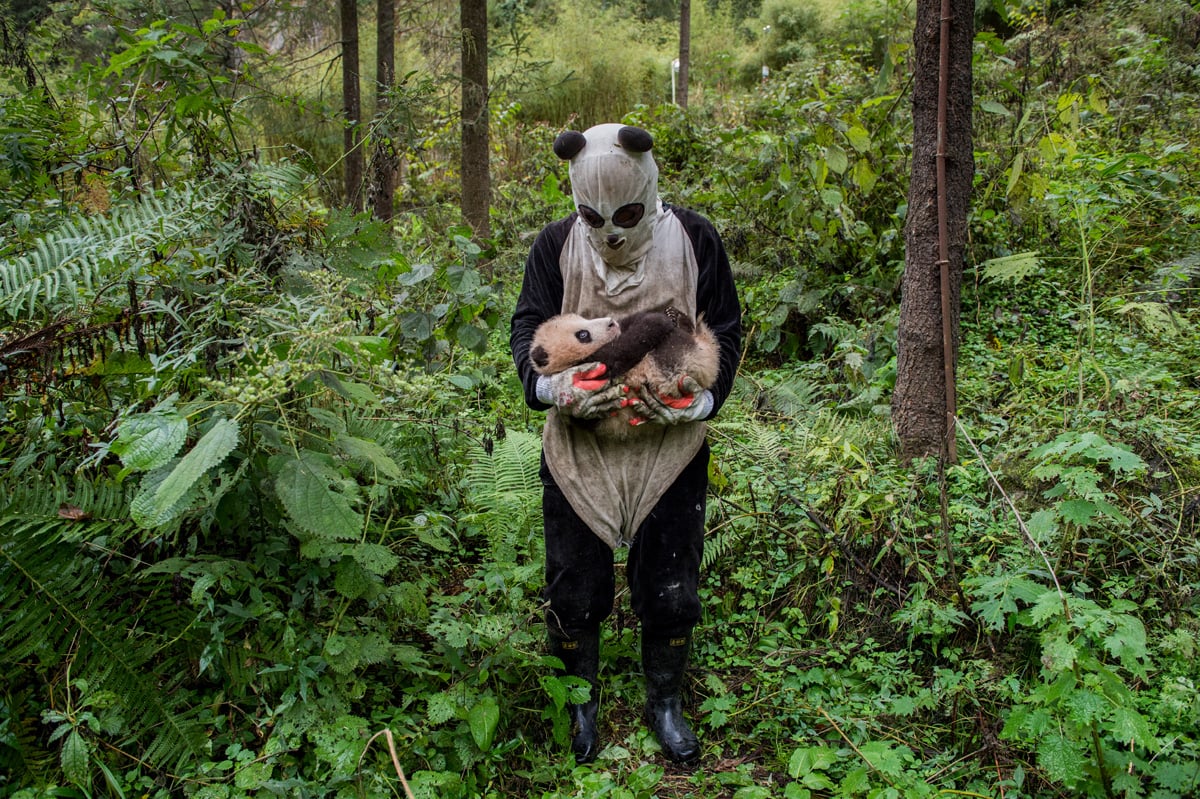
Photographer Ami Vitale has documented the devastating effects of the 2004 Indian Ocean tsunami and the toll of the Israel-Palestinian conflict. But none of these dramatic journeys to conflict zones required quite as much commitment as her stint photographing pandas in China’s Sichuan Province. To blend in with the locals, she had to don a panda suit scented in urine and feces.
“It was like waking up and being inside a live Wes Anderson film every day,” she explains.
This is now a regular workday for Vitale, a contract photographer for National Geographic who gave up her other gigs to document wildlife full-time in 2009. Last year, Hardie Grant published her book Panda Love: The Secret Lives of Pandas, a bestselling compilation of photos that tells the story of these gentle giants.
On the heels of a United Nations report released earlier this month that one million plant and animal species face extinction due to climate change, Vitale sees her work as a critical way to encourage the public to connect with wildlife and nature more broadly. Next month, as part of an ongoing speaking circuit, she will give a keynote lecture about her work at Aperture Australia’s photography conference in Sydney, held on June 22 and 23.
Ami Vitale in Kenya. Photo: Bryan Liscinsky.
Vitale has traveled to over 100 countries for her work, navigating any number of crazy conditions, from “blinding heat in deserts to being up to the neck in marsh water” to get her shots. She’s contracted malaria many times and been charged by elephants, rhinos, bears, and—just last month—a wild buffalo in Kenya. She’s also recognized as one of the most accomplished artists in her field, having won the International Photographer of the Year prize, the Daniel Pearl Award for Outstanding Reporting, National Press Photographer’s Association Magazine Photographer of the Year award, and five World Press Photo prizes.
Vitale got her start shooting for a small news outlet in North Carolina before moving on to larger publications as she covered conflict zones around the world. But after years of documenting human pain inflicted in the name of money and political power—from wars in the Middle East and social strife in the Balkans, to the “cost of coal” in the American heartland—Vitale decided to focus her lens elsewhere.
“Seeing man’s capacity for brutality and inhumanity literally almost killed me,” she says. “That’s what brought me back to nature.”
There she found that she didn’t need to photograph warfare to tell stories of struggle and resilience. She points to an exchange with an elementary school class while she was shooting the last two living female white rhinos in Kenya last month. After her talk, conducted on video from the field, the children were so moved that they raised several thousand dollars in support of the sanctuary. This, she says, is the power of animals: “That those kids can understand an idea as abstract as extinction and feel the impulse to react to it in a tangible, active way—it’s really amazing.”
© Ami Vitale. Courtesy of the artist.
A similar belief compelled her to delve into the world of pandas. Over the course of three years and five long trips to China, the photographer captured pandas in nature reserves within the country’s Sichuan Province.
“I thought if the Panda could hook people—because they’re cute and adorable and fluffy—maybe they can be an ambassador for all species in danger, which we’re all connected to,” she explains. “My stories may look like wildlife photographs, they’re really not. They’re actually stories about humanity. In almost every single image, you’ll understand that there is no place on the planet without humanity.”
As such, “the same rules that come with photographing people apply to photographing wild animals,” she says. It’s important to gain an animal’s respect before taking their picture, much in the same way you would obtain a person’s consent before snapping a portrait. She has to make sure she’s documenting a shared experience with her subjects, not capturing their likeness to exploitative ends. This is why Vitale often spends several years working on individual projects—it sometimes takes that long for her subjects, many of whom are traumatized or orphaned, to trust her.
Culturally, the panda is ubiquitous. Yet there’s a great deal about the animal that scientists don’t understand. In fact, Pandas are believed to have lived on the planet for millions of years before being discovered by mankind in the 19th century. Highly solitary creatures, they live in forests in remote mountainous regions of southwestern China, and often only come into contact with others from their kind for a two to three days a year, when they mate.
One-year-old Giant panda cub Na Na explores the forest at Wolong China Conservation and Research Center for the Giant Panda in Sichuan Province, China September 6, 2015. Photo: Ami Vitale.
“We’ve turned them into a cartoon character, but that’s not what they are,” says Vitale. “They are nothing like that.”
Today, there are roughly 1,800 pandas in the wild, up some 17 percent over the last decade. The species was removed from the endangered species list in 2016, the result of concerted strategies by the Chinese government to breed the animal and reforest its habitats. Seeing the success of those efforts up close reiterated the importance of her work.
“It’s all connected,” she explains. “If we can understand and have reverence for nature, we can have reverence towards one another. It’s the same thing.”
See more of Vitale’s photos below:
© Ami Vitale. Courtesy of the artist.
© Ami Vitale. Courtesy of the artist.
© Ami Vitale. Courtesy of the artist.
© Ami Vitale. Courtesy of the artist.
© Ami Vitale. Courtesy of the artist.